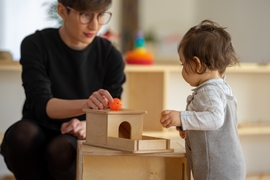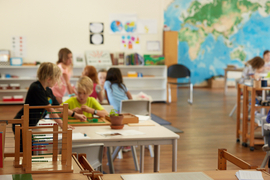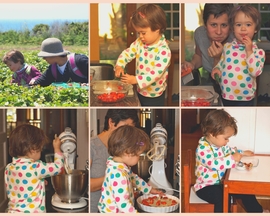
The following article was published in EduResearch Matters (Australia Association for Research in Education) by Montessori Australia's Director of Education Services Mark Powell. It is a response to Pasi Sahlberg and Sharon Goldfeld's article "If not now, then when is the right time to re-envisage what schools could be?".
To paraphrase Pasi Sahlberg et al in Reinventing Australian Schools, our education vehicle is on the blink. Despite decades of well-intentioned declarations and reforms, increased funding, and the everyday professionalism of our educators, Australian education is unequal, underperforming and unwell.
Although students with educated parents and ample means are more likely to get what they need from their schools, the engine that powers our collective future leaves too many students behind, and not only those from disadvantaged groups. At the same time, our young people have some of the lowest levels of mental health and wellbeing among wealthy countries. As evidenced in the NSRA Study Report, educators too have been suffering and are leaving classrooms in record numbers, with the heavy workload, stress and the need for a better work/life balance cited as the main reasons for leaving the profession.
Sahlberg et al argue for a bold alternative to our education status quo, beginning with a reassessment of the purpose of education that acknowledges the connection between academic learning and health and wellbeing. Their bold alternative would get “rid of anything that does not support a whole child and whole school approach…This approach requires fostering high levels of trust, positive relationship, and collaboration between students and teachers, all teachers and administrators, and parents, communities and schools. For maximum effect, it would also require…more interconnected collaboration between sectors at the system level as well” (pp. 8, 14, 9).
Re-building the macro-level components of our education machinery will certainly be essential in harnessing the connection between learning and wellbeing to aid the development of the whole child. However the most pivotal mechanism in need of a re-design is the one most often overlooked in discussions of education reform—the classroom itself.
Classroom educators understand that relationships are where the rubber meets the road. Connection, collaboration and the trust that allows learners to become co-creators in their own learning are keys to student engagement and wellbeing. These are the elements that give learning meaning for young people. However the quality of classroom relationships is more powerfully constrained by the design of the classroom than by the quality of the individual teacher or the quantity of the systems that support them.
Here are two classrooms from around the same time period that have been designed for different kinds of relationships. The one on the left was engineered for relationships based on top-down authority, compliance, obedience, conformity and competition. This classroom design is so pervasive that it is often assumed to be the only viable way that classrooms can be arranged. In contrast, the learner-centred classroom on the right was engineered to encourage engagement, trust, creativity, individuality and collaboration by prioritising relationships and wellbeing. These two designs are built on different assumptions about children and how they learn, and very different beliefs about the purpose of education.
Here’s the rub. When education is focused primarily on adult priorities like academic outcomes, preparation for work, or convenience for adult scheduling, classrooms tend to be designed for control and so relationships become secondary. This erodes trust and connection between teachers and students, with negative implications not only for mental health and wellbeing but for academic outcomes too.
The solar system graphic illustrates a learner-centred classroom design engineered to activate real choice, personal connection, and collaborative learning. Its central feature is the three-year grouping, which energises the classroom system like the Sun energises our solar system. It goes much further than composite classrooms (single-year classrooms merged together) by grouping learners in developmental stages rather than by chronological age. This gives children time to mature at their own pace within a developmental window. Its many advantages for the wellbeing and mental health of children and educators are multilayered and built into the design itself, so they reinforce one another without explicit instruction.
This learner-centred design mimics familial relationships as children cycle through being the youngest (the “awestruck follower”), then the middle child (the “observant and sometimes overconfident apprentice”), and finally the eldest (the “experienced and nurturing leader”). Children experience each role over and over as they pass through multiage classrooms for infants to three year-olds, 3 to 6 year-olds, 6 to 9 year-olds, 9 to 12 year-olds, 12 to 15 year-olds, and 15 to 18 year-olds. The focus on developmental readiness and position within the classroom system—rather than chronological age—acknowledges students’ experience and abilities while freeing them of the expectation that they should be the same as their peers of the same age. It also adds stability by preserving an institutional memory of traditions, norms and rituals in returning students.
This design flattens classroom management as problems are more often worked out by students instead of needing solutions to be imposed by adults. Students tend to respond more positively to direction from older peers whom they have relationships with, and this relieves educators of the need to constantly manage the classroom, affording them space to observe individuals without distraction.
The three-year structure also orients children’s minds to an appreciation of diversity by prompting them to look for commonalities. Research has shown that children in homogenous groupings tend to search for differences, which promotes clique behaviour, while children placed in diverse groupings tend to look for ways they are the same.
The three-year design makes possible real choice, the engine of motivation. Choice is possible where the teacher is freed from having to manage the whole classroom at once. Children learn through interacting with manipulatives placed on the shelves by educators, and less through direct instruction. The materials each contain their own control of error that draw students’ attention to mistakes, so the role of the educator is primarily to observe and guide individuals toward follow-up activities that suit their particular needs, rather than correct their mistakes. With classroom management handled mostly by older students, teachers can give small group or individualised lessons based on readiness rather than age. Individualised attention becomes routine, rather than an exception to be mobilised only when students struggle.
Giving children real choice unleashes hidden reserves of motivation, so easily extinguished when children are herded and cajoled. Learners invest more of themselves in an activity if they’ve had some say in choosing it. When given real choice from an array of concrete experiences, children construct their own understandings at their own pace. They don’t have to keep up with peers in order to conform to the teacher’s schedule, so they avoid the most corrosive effects of competition.
The three-year design also makes possible deep personal connections. Students build strong bonds of trust with the same teacher over three years. Teachers get to know their returning students well, so they know which stories and activities will capture their imaginations and motivate them. This trust encourages orderly freedom of movement and association. In this atmosphere children feel safe enough to see their mistakes as opportunities to learn rather than personal failures. Children are known by the educators who work with them, and authentic assessments are gathered to show meaningful progress over time.
There’s also more trust between educators and parents with this learner-centred design. Since each child is with their teacher for three years there’s an incentive for the teacher to get to know parents and develop good relationships with them. In this classroom model, permanent teacher aides are genuine partners with their lead, rather than itinerant visitors with fleeting connection to students.
Finally, the three-year design makes possible genuine collaborative learning, allowing students to learn from one another at least as much as from teachers. Peer-to-peer learning is enhanced because students are free to choose when, where and with whom they engage in activities. Children don’t all develop at the same pace so a multiage collaboration between any two children may imply a mentoring relationship or it may be a collaboration of equals. Students in this environment understand that everyone in the room—adults included—can be both student and teacher at different times.
This learner-centred design makes possible real choice, deep connection and genuine collaboration. These wellbeing features are built into the design itself so they reinforce one another in the background, and don’t require add-ons (like “brain breaks”) which interrupt students’ concentration without solving the problems inherent in the single-year adult-focused design. Learner-centred classrooms are designed to promote engagement, trust and genuine collaborative relationships from the moment children step into them to the moment they leave as confident, independent young adults.
As long as education continues to serve the interests and convenience of adults first and foremost, the interests and wellbeing of young people will take second place. If all our young people and their educators are to realise their full potential, the education vehicle that drives their development must be re-engineered with their interests and wellbeing at its core.



